Topic: Generalized Bedrock Geology Of New York State
Generalized Bedrock Geology Of New York State
Which type of surface bedrock is most commonly found in the Utica, New York area?
(1) sedimentary, with limestone, shale, sandstone, and dolostone
(2) sedimentary, with limestone, shale, sandstone, and conglomerate
(3) metamorphic, with quartzite, dolostone, marble, and schist
(4) metamorphic, with gneiss, quartzite, marble, and slate
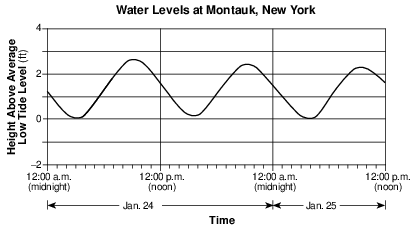
What is the approximate latitude and longitude of the tide gauge?
(1) 40°30' N 72°00' W
(2) 40°30' N 74°00' W
(3) 41°00' N 72°00' W
(4) 41°00' N 74°00' W

In which major watershed is the Susquehanna River located?
(1) F
(2) H
(3) I
(4) J
The map below shows the locations of some oil and gas fields in New York State.
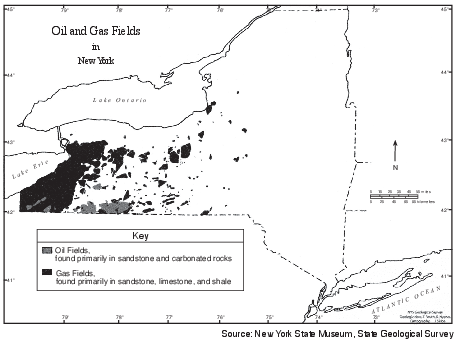
Which type of bedrock contains these oil and gas deposits?
(1) extrusive igneous rock
(2) intrusive igneous rock
(3) metamorphic rock
(4) sedimentary rock
The map below shows the present-day positions of the continents. Points A through D represent locations on Earth’s surface. The location of New York State on the North American continent is indicated.

Which letter best represents the inferred position of the New York State region on Earth at the end of the Devonian Period?
(1) A
(2) B
(3) C
(4) D
The map below shows the average annual snowfall, in inches, for western New York State.

According to the map, which of these cities receives the greatest average annual snowfall?
(1) Buffalo
(2) Jamestown
(3) Niagara Falls
(4) Elmira
Sedimentary rock layers that were deposited between 488 million and 444 million years ago are found on the surface at which two New York State locations?
(1) Ithaca and Jamestown
(2) Utica and Syracuse
(3) Oswego and Old Forge
(4) Albany and Massena
Which two cities are located in the Interior Lowlands?
(1) Elmira and Binghamton
(2) Riverhead and New York City
(3) Massena and Old Forge
(4) Buffalo and Watertown
What is the approximate altitude of Polaris when viewed from New York City?
(1) 90°
(2) 74°
(3) 49°
(4) 41°
The surface bedrock of Mt. Marcy, New York, is composed primarily of which rock?
(1) anorthosite
(2) marble
(3) quartzite
(4) hornfels
Which New York State landscape region is composed of mostly horizontal sedimentary bedrock and has a high elevation?
(1) Hudson Highlands
(2) Manhattan Prong
(3) the Catskills
(4) Taconic Mountains
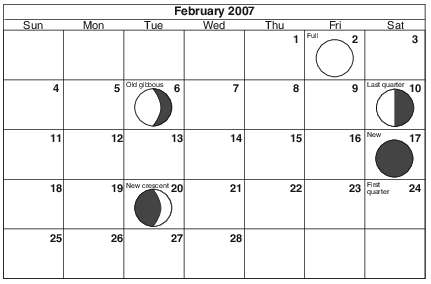
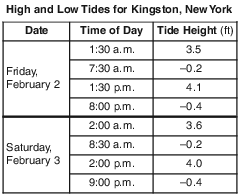
Determine the altitude of Polaris at Kingston, New York, to the nearest degree. [1]
°
Allow 1 credit for 42°.
Identify the air temperature at Watertown, New York. [1]
______________ °F
Allow 1 credit for any value from 39°F to 41°F.
On the map in the image provided, place an X at a location where the gastropod fossil Platyceras might be found in the surface bedrock. [1]
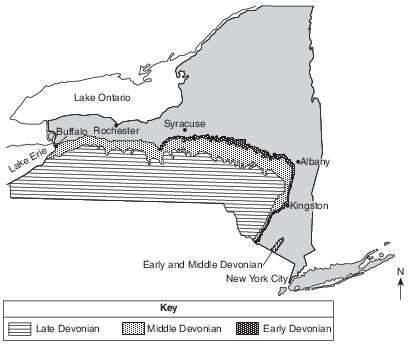
Allow 1 credit if the center of the X is within the Middle Devonian zone or the Early and Middle. Devonian zone located northwest of New York City.
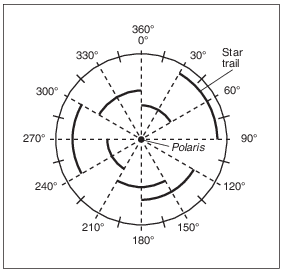
Record, to the nearest whole degree, the altitude of Polaris when it is viewed from the top of New York State’s Mt. Marcy. [1]
°
Allow 1 credit for 44°.
• Note: Do not allow credit if a compass direction is given (e.g., 44 N or 44° N) because that
• denotes latitude, not altitude.
